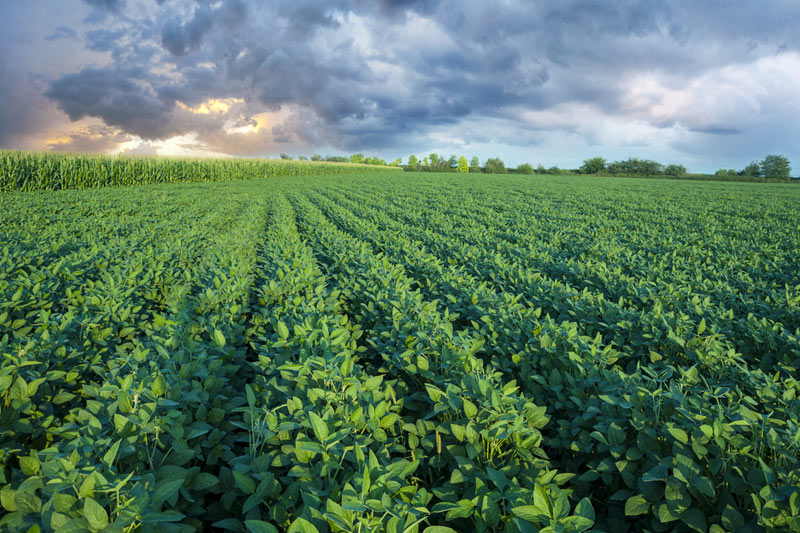Investing.com - U.S. soybean futures inched up modestly on Tuesday, but held near the lowest level in almost eight months amid indications of rapid planting progress in the U.S. Midwest.
On the Chicago Mercantile Exchange, US soybeans for July delivery inched up 2.23 cents, or 0.24%, to trade at $9.2663 a bushel during U.S. morning hours.
Grain markets were closed on Monday due to the U.S. Memorial Day holiday. Prices of the oilseed fell to $9.2260 on Friday, a level not seen since October 13, before settling at $9.2420, down 14.2 cents, or 1.52%.
Nearly 45% of the soybean crop was planted as of May 17, according to the U.S. Department of Agriculture, compared to 31% in the same week a year earlier, while the five-year average for this time of year is 36%.
Later in the day, the USDA will release updated crop progress numbers for the week ended May 24. The report comes out one day later than usual due to Monday's Memorial Day holiday.
Meanwhile, US corn for July delivery shed 0.52 cents, or 0.15%, to trade at $3.5988 a bushel. On Friday, corn lost 5.0 cents, or 1.37%, to close at $3.6000.
According to the USDA, approximately 85% of the corn crop was planted as of May 17. Nearly 71% of the crop was planted during the same week a year earlier, while the five-year average for this time of year is 75%.
Elsewhere on the Chicago Board of Trade, US wheat for July delivery slumped 2.58 cents, or 0.5%, to trade at $5.1263 a bushel. Wheat dropped 6.6 cents, or 1.29%, on Friday to end at $5.1520.
Updated weather forecasting models pointed to more rainfall in the U.S. Great Plains-region later this week, which could potentially damage the maturing winter-wheat crop.
The USDA said that the U.S. winter wheat crop was rated 45% good to excellent as of May 17, while almost 94% of the spring wheat crop was planted. Only 47% of the crop was planted in the same week a year earlier, while the five-year average for this time of year is 65%.
Corn is the biggest U.S. crop, followed by soybeans, government figures show. Wheat was fourth, behind hay.
- English (UK)
- English (India)
- English (Canada)
- English (Australia)
- English (South Africa)
- English (Philippines)
- English (Nigeria)
- Deutsch
- Español (España)
- Español (México)
- Français
- Italiano
- Nederlands
- Português (Portugal)
- Polski
- Português (Brasil)
- Русский
- Türkçe
- العربية
- Ελληνικά
- Svenska
- Suomi
- עברית
- 日本語
- 한국어
- 简体中文
- 繁體中文
- Bahasa Indonesia
- Bahasa Melayu
- ไทย
- Tiếng Việt
- हिंदी
U.S. soybean futures trade near 8-month low on planting progress
Published 05/26/2015, 06:08 AM
U.S. soybean futures trade near 8-month low on planting progress

Latest comments
Install Our App
Risk Disclosure: Trading in financial instruments and/or cryptocurrencies involves high risks including the risk of losing some, or all, of your investment amount, and may not be suitable for all investors. Prices of cryptocurrencies are extremely volatile and may be affected by external factors such as financial, regulatory or political events. Trading on margin increases the financial risks.
Before deciding to trade in financial instrument or cryptocurrencies you should be fully informed of the risks and costs associated with trading the financial markets, carefully consider your investment objectives, level of experience, and risk appetite, and seek professional advice where needed.
Fusion Media would like to remind you that the data contained in this website is not necessarily real-time nor accurate. The data and prices on the website are not necessarily provided by any market or exchange, but may be provided by market makers, and so prices may not be accurate and may differ from the actual price at any given market, meaning prices are indicative and not appropriate for trading purposes. Fusion Media and any provider of the data contained in this website will not accept liability for any loss or damage as a result of your trading, or your reliance on the information contained within this website.
It is prohibited to use, store, reproduce, display, modify, transmit or distribute the data contained in this website without the explicit prior written permission of Fusion Media and/or the data provider. All intellectual property rights are reserved by the providers and/or the exchange providing the data contained in this website.
Fusion Media may be compensated by the advertisers that appear on the website, based on your interaction with the advertisements or advertisers.
Before deciding to trade in financial instrument or cryptocurrencies you should be fully informed of the risks and costs associated with trading the financial markets, carefully consider your investment objectives, level of experience, and risk appetite, and seek professional advice where needed.
Fusion Media would like to remind you that the data contained in this website is not necessarily real-time nor accurate. The data and prices on the website are not necessarily provided by any market or exchange, but may be provided by market makers, and so prices may not be accurate and may differ from the actual price at any given market, meaning prices are indicative and not appropriate for trading purposes. Fusion Media and any provider of the data contained in this website will not accept liability for any loss or damage as a result of your trading, or your reliance on the information contained within this website.
It is prohibited to use, store, reproduce, display, modify, transmit or distribute the data contained in this website without the explicit prior written permission of Fusion Media and/or the data provider. All intellectual property rights are reserved by the providers and/or the exchange providing the data contained in this website.
Fusion Media may be compensated by the advertisers that appear on the website, based on your interaction with the advertisements or advertisers.
© 2007-2024 - Fusion Media Limited. All Rights Reserved.